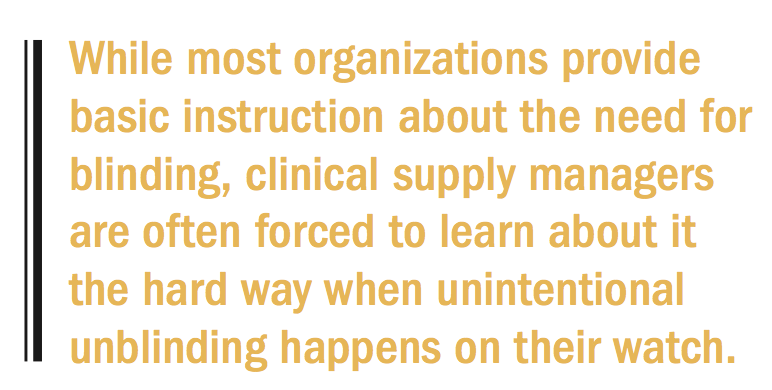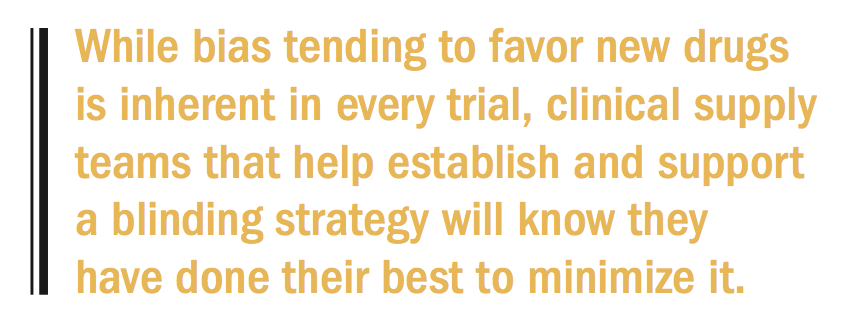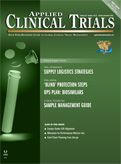6 Ways to Protect the Blind in Clinical Trials
Applied Clinical Trials
An overview of clinical supply blinding methods in the context of the current research environment.

Clinical supply professionals are on the front lines of protecting one of the most important aspects of clinical trial conduct-the blind. The terms “blinding” or “masking” in a clinical trial refer to the experimental method of keeping certain participants unaware of specific treatment assignments.1 When conducted successfully, blinding can reduce bias in randomized trials. However, study integrity may be at risk if the blind is broken unintentionally.
At its most basic level, the concept of blinding appears simple, but in reality there are many practical considerations that add several degrees of difficulty.2 In recent years, this level of complexity has increased with protocol design advances and more people involved in supporting clinical studies. The need for blinding has grown within some medical specialties such as oncology, where early phase researchers are looking beyond safety studies toward evaluation of efficacy, which may require blinding of clinical supplies.3
Today, there is greater electronic risk of releasing sensitive, unblinded, information to trial personnel who are supposed to be blinded. Adding new challenges for clinical supply operations are new research methods such as adaptive design, which can introduce changes in treatment assignment after an interim analysis.
Despite the high burden of risk placed on clinical supply professionals, there are limited training resources and literature available on this topic.4 While most organizations provide basic instruction about the need for blinding, clinical supply managers are often forced to learn about it the hard way when unintentional

unblinding happens on their watch.
In light of these challenges, the authors identified six ways that supply chain professionals can help protect the blind in clinical trials. Since the promise of adaptive design has captured the attention of many clinical researchers, we address its implications before more general considerations. We begin with our recommended priority list:
- Participate early in design planning for adaptive trials
- Ensure proper technology configuration for adaptive trials
- Consider all five human senses
- Build a blinding procedures checklist using the protocol
- Stay vigilant during administrative tasks
- Reinforce initial responsibilities
Our first suggestion for protecting the blind comes as adaptive design made news. In May 2015, the U.S. FDA issued guidance extending its recommendations to adaptive medical device trials.5 Five years ago, the agency issued its guidance for adaptive drug studies. These guidance documents offer helpful information for clinical supply professionals as they consider tip one.
Participate early in design planning for adaptive trials
An adaptive trial is a multi-stage study that uses accumulating data to modify trial conduct without compromising integrity. Modification plans are established in study design and triggered when an interim analysis shows that adapting the trial may improve efficiency. Many pharmaceutical companies have successfully adopted this method across their clinical developmental portfolios. For instance, Merck & Co. reported in 2011 that it introduced adaptive design for 40% of its late-stage clinical trials and saved over $200 million as a result.6
When adaptive trials are in the design stage, clinical supply professionals can help establish procedures for responding to those changes that would have the highest operational impact. It will be important to prepare the blinding strategy for the following adaptive events:
- Sample size adjustments
- Modified randomization to drop or add treatment arms or doses
- Re-randomization of the same patients
- Changes to the allocation ratio or treatment assignment probabilities
- Stopping early due to success or predicted failure
If clinical supply professionals bring strategy considerations to the table early, it may help shape the proposed adaptations so they include workable measures that prevent accidental unblinding. Note that there may be additional challenges because adaptive designs are typically used early in development when drug supplies are hard to come by or difficult to manage due to unconfirmed stability.
As the FDA stated in its draft guidance on adaptive design in drug trials, “protecting the study blind is particularly important to avoid the introduction of bias in the study conduct and to maintain confidence in the validity of the study’s results.” A sound clinical supply strategy is essential to ensuring this protection remains robust while the trial conduct changes in response to clinical results.
Ensure proper technology configuration for adaptive trials
Interactive response technology (IRT), also known as interactive voice or web response systems (IVRS/IWRS), usually plays a large role in designing and controlling adaptive trials so that randomization, the supply chain, and blinding strategy remain robust and protected. Preparing an adaptive design without adequate technology is not recommended, especially in larger trials.
If a study sponsor does not have this technology in place, clinical supply professionals are well placed to help select the appropriate software. Once the technology is installed, a biostatistician-often working with the clinical trials team-can ensure it is configured properly with features such as the ability to turn on or off treatment arms within one schedule (a randomization list or drug packaging list). Adaptive trials often call for creative ways of using IRT to improve clinical supply forecasting, supply strategy adjustment, expiry date management, and study medication blinding maintenance. An experienced clinical supply manager has the ability to respond to this complexity by:
- Providing input into the configuration of the drug packaging list
- Participating in the communication of batch releases that must be recognized in the IRT
- Ensuring the process for shipping of materials is established and followed based on orders sent by the IRT to the depots
- Providing input or authorization to the overall materials being managed by the IRT
- Ensuring the naming and unitization elements align with the physical nature of the materials
â
Consider all five human senses
In both adaptive design and traditional study design, clinical supply teams can work in tandem with formulation experts to ensure the test articles have matching physical attributes. When reviewing designs for these products, remember to consider all five human senses. The requirement for matching must go beyond the actual product characteristics and extends to all associated packaging and labeling.
The original manufacturer’s stability data usually supports only the medicine in its original packaging. Unless equivalent or more protective packaging is used, which itself may be difficult to determine, a reduction in the medicine expiry date may be unavoidable.2
During a recent online forum about blinding clinical supplies, several questions were introduced by the audience about matching physical properties of investigational drugs to placebos or comparators.7 The attendees were especially concerned about masking the visual identity of liquid presented in syringes.
One proposed solution is the use of polyethylene soft shells that obscure the color and cloudiness of some liquids. Another person in attendance noted the complications of matching product taste in liquid formulations. Compared with tablets and capsules, the sensory characteristics of taste and smell are more pronounced and more challenging to duplicate. This issue of blinding liquids comes up frequently in pediatric clinical trials that rely on these dosage forms to ease administration.
The relative importance of the sensory evaluation depends on the route of administration and the dosage form. When it comes to blinding capsules, for instance, a simple solution such as over-encapsulation will usually provide sufficient masking. But the same can’t be said of injectable therapies where the viscosity of the study drug differs substantially from the placebo, or inhalants with slightly different odors. In all cases, it makes sense to understand how perceptions of the test articles are influenced by shape, size, color, texture, weight, taste, and smell.
Build a blinding procedures checklist using the protocol
Though they can be involved early in the trial design, in many cases, clinical supply professionals have most of the protocol delivered to them in final form from their clinical colleagues. With this document in hand, it may pay dividends to build a simple blinding procedures checklist for clinical supplies. The one-page checklist makes it easier to recall specific details from among the many trials that are often running concurrently. The form can start with blank fields for the protocol number and title, followed by name and contact information for the relevant project manager.
Open checkboxes on the page enable a supply team member to select the protocol design type (open label, single blind, double blind or triple blind), the trial personnel who will remain blinded and unblinded to treatment assignments (client/sponsor, project manager, investigators, study coordinators, monitors, analysts, etc.), and the randomization system. At the end of the page, include blank fields with name, affiliation, address, and phone number to identify the contact people to notify in case of an emergency unblinding, and those who have the authority to unmask the study results.
Beyond items used in the blinding checklist, the protocol should provide more details about the method of blinding-for instance over-encapsulation for capsules and tables, or the soft shells described above for syringes and vials. It can also discuss the similarity of treatments based on appearance, taste, or other characteristics. And finally, it will give full instructions for unblinding the study treatment if an emergency dictates a break in the blind is warranted.
Stay vigilant during administrative tasks
As noted, email and other electronic communications among trial personnel can inadvertently reveal treatment allocation. These communications include both written text and attachments (randomizations and print run reports showing ranges with treatment groups, batch documentation showing what is being packaged with ranges, packing and return lists, invoices, shipping documents, etc.). In some cases, exclusive details are benign, but when coupled with a second exclusive detail they lead to full or partial unblinding.
With the proliferation of email, web portals, instant messaging and other electronic communication channels, it is harder today to stay vigilant during administrative tasks that often become routine. Before sending a message, it always makes sense to ask recipients if they are blinded to the study information. If they are, ask for an individual who is unblinded and can provide the approvals or have the documentation blinded before forwarding it to the preferred contact.
Too often what gets transmitted are unique sequence numbers associated with each material unit of active drug and placebos. These numbers would not appear on the label, but are used in site shipment requests. As the name suggests, the numbers are provided sequentially and grouped based on the drug type (active might be sequence numbers 1-10 and placebo might be sequence numbers 11-20, for example). This makes it easier to pull and box supplies. But if these numbers were learned, it is possible to group or deduce the drug type, if provided additional reference information.
Limit access to these numbers to the unblinded personnel who use the codes to reassign treatments when necessary, such as after an interim analysis in an adaptive trial.
It’s also important that the sequence numbers themselves can’t be traced. Study volunteers may be able to identify their assignment based on mild side effects such as flushing of the face or a metallic taste in the mouth. If several volunteers with similar numbers experience the same side effect it could compromise the blind.
Other potential unblinding hazards are misaligning the label on medication kits, variance in label text, color or print style, different carton substrates, carton assembly, and tampers seals placed differently.
Apart from email, other electronic information sharing presents unblinding risk. For example, granting inappropriate access to secure content in a web portal may give blinded trial personnel details about the end product and, therefore, the potential to break the blind.
Shipping documentation, both in electronic and hard copy format, presents another administrative pitfall, especially for trials that share drug supplies across multiple protocols. Historically, customs officials need to know what is in the shipping container and it is commonly stated on the packing list or commercial invoice. In the case of supply sharing or “pooling,” the packing list would show “Material Pooled” with the material or randomized numbers listed, items for Protocol XYZ and an associated invoice that would list X product of active or placebo with a unit cost and the subtotal.
Reinforce initial responsibilities
Accidental unblinding may also happen when a distribution center fails to remove all the drug identification packing slips from shipping cartons, or if a laboratory doing sample analysis mistakenly sends the investigators results sorted by treatment type. This brings up the importance of reinforcing initial responsibilities throughout the clinical supply chain.
As noted, clinical trial conduct is often a team effort that spans many time zones, countries, languages, and organizations. Setting appropriate management practices is as important as reinforcing them throughout the trial.
Part of this initial planning is the design of a strategy for unblinding, in case of an emergency, as noted earlier. Established in the protocol, methods for fast and efficient unblinding can include tear off strips that are removed from the packaging and stored in the site pharmacy for emergency access. IRT systems, when used, provide the immediate access for emergency unblindings to be performed. The IRT will communicate the patients treatment assignment. Access to such a transaction would be controlled by user role and any protocol-specific conditions that must be met in order to unblind a patient. Clear

instructions and lines of communications will help ensure proper use of these emergency procedures.
In closing, these are just a few steps that clinical supply professionals can take to protect the blind and prevent bias. The impact of bias on the evaluation of treatment effect is difficult to assess, but it has been estimated that the absence of double-blinding exaggerates treatment effects by 14% as compared with double-blind trials.8 While bias tending to favor new drugs is inherent in every trial, clinical supply teams that help establish and support a blinding strategy will know they have done their best to minimize it.
Leon Wyszkowski is Vice President, North America and Facility Network; Steven Yoder is Managing Director; Susan Diehl is Project Manager; all with Fisher Clinical Services
References
1. Wang D, Bakhai A. Clinical Trials: A Practical Guide to Design, Analysis, and Reporting. Remedica, 2006, 480 pages.
2. Wan M, Orlu-Gul M, Legay H, Tuleo C. Blinding in pharmacological trials: the devil is in the details, Archives of Disease in Childhood, Sept 2013; 98: 656 - 659.
3. Percy Ivy S, Siu LL, Garrett-Mayer E, Rubinstein L. Approaches to Phase 1 Clinical Trial Design Focused on Safety, Efficiency, and Selected Patient Populations: A Report from the Clinical Trial Design Task Force of the National Cancer Institute Investigational Drug Steering Committee. Clinical Cancer Research 2010; 16:1726-1736.
4. Cook S, Yoder S, Owings C, Campbell B, Gentile C. The Blinding of Materials in Clinical Trials: Essential Processes for Ensuring the Integrity of Clinical Study Data. Pharmaceutical Engineering, January/February 2014, Vol. 34 No. 1.
5. Adaptive Designs for Medical Device Clinical Studies, Draft Guidance for Industry and Food and Drug Administration Staff. Food and Drug Administration Center for Devices and Radiological Health, Center for Biologics Evaluation and Research, May 18, 2015.
6. He W, et al. Practical Considerations and Strategies for Executing Adaptive Clinical Trials. Drug Information Journal, 2012; 46(2) 160-174.
7. Diehl S, How to avoid breaking the blind in clinical trials. Xtalks Webinar, March 18, 2015. http://xtalks.com/blinding-in-clinical-trials.ashx. Accessed June 9, 2015.
8. Casteels M, Flamion B. Open-label trials and drug registration: a European regulator’s view. Journal of Thrombosis and Haemostasis, 2008; 6:232–4.

Improving Relationships and Diversifying the Site Selection Process
April 17th 2025In this episode of the Applied Clinical Trials Podcast, Liz Beatty, co-founder and chief strategy officer, Inato, discusses a number of topics around site engagement including community-based sites, the role of technology in improving site/sponsor relationships, how increased operational costs are impacting the industry, and more.
Behind the Buzz: Why Clinical Research Leaders Flock to SCOPE Summit
February 7th 2025In this episode, we meet with Micah Lieberman, Executive Conference Director for SCOPE Summit (Summit for Clinical Ops Executives) at Cambridge Innovation Institute. We will dive deep into the critical role of collaboration within the clinical research ecosystem. How do we bring together diverse stakeholders—sponsors, CROs, clinical trial tech innovators, suppliers, patients, sites, advocacy organizations, investors, and non-profits—to share best practices in trial design, program planning, innovation, and clinical operations? We’ll explore why it’s vital for thought leaders to step beyond their own organizations and learn from others, exchanging ideas that drive advancements in clinical research. Additionally, we’ll discuss the pivotal role of scientific conferences like SCOPE Summit in fostering these essential connections and collaborations, helping shape the future of clinical trials. Join us as we uncover how collective wisdom and cross-industry partnerships are transforming the landscape of clinical research.